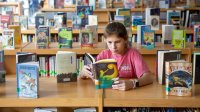A School-Wide Focus on Choice Reading
When the staff at an elementary school made fostering a love of reading a priority, they used these strategies to meet their goal.
Your content has been saved!
Go to My Saved Content.As educators, how do we build literacy-rich environments to grow happy readers? After years of achievement roadblocks, Yorkville Grade School, a Title 1 elementary school in a consolidated unit district 50 miles west of Chicago, made a shared decision to place growing happy readers at the top of the priority list. We refocused on books, and students rediscovered book joy.
This unified centering on books, choice, and voice can transform the way a school lives and breathes. Here are some tips that can help you and your school grow happy readers.
Focusing on Literacy
Money talks: Research shows that a robust, diverse library directly correlates to student achievement. School libraries are a good start, but only a start. In Donalyn Miller and Colby Sharp’s book, Game Changer: Book Access for All Kids, the authors cite several respected experts who recommend that a classroom library contain 300 to 1,000 books.
This isn’t a project or onetime focus. It’s a new mindset that requires breaking ingrained routines. Often, school funds are used for pricey, quick-fix resources that end up in a closet a year later. For example, a boxed program with fluency or comprehension task cards may seem straightforward, but it often fails to cultivate readers on a deeper level. In two years alone, with a modest budget, our elementary school shifted enough money to allocate $15,000 to books and only books.
As a first step, principals should conduct a soft budget audit to review how money is allocated and in what way. Then principals and parent-teacher organizations should designate classroom books as a recurring line item in the budget.
Determine where to spend less in order to allocate more on books. For example, when we shifted our focus to books and technology integration, paper demand decreased. Bigger purchases such as devices or online subscriptions were reallocated to the district level. District-wide purchases of Lexia or DreamBox can save money by reducing the student subscription rate. This also allows us to be consistent across all learning models, so remote learners and in-person students have access to a device and online learning programs. The pandemic is a good time to look at funds that schools are no longer utilizing in the same way and shift that money into other priorities such as books.
Pinch pennies: Once teachers have yearly funds distributed by the school, stretching the dollar is a must. Yorkville school librarian Steph McHugh plays a vital role in our penny-pinching habits. For example, through Scholastic and local vendors, $12 books can be bought in bulk for $1 each. Teachers also take advantage of accumulated points to cash in for heaps of bonus books. In recent years, our school purchased three times the volume of books over years past.
Bulk shopping allows for school principal birthday books and keepsakes to reinforce shared efficacy and book love. On the 100th school day of this school year, the book Ruby Finds a Worry by Tom Percival was gifted to every student. In a year full of worry, this intentionality matters.
Take a closer look: Before shopping for books, teachers need adequate time to conduct a classroom library inventory, which will help them decide if title selections are relevant, diverse, and engaging. Professional learning about this topic can help teachers ensure literacy best practices.
Think creatively. This year, Ramped-Up Read Aloud author Maria Walther collaborated with teachers to select authentic books and instill reading routines.
Hand over the keys: Teachers can create child-friendly surveys to solicit feedback about desired topics, genres, series, and authors. In third grade at our school, the students hold the keys to their classroom libraries. At morning meeting, the class compiles book ideas; then students curate the shopping cart while staying within budget.
Students organize newly arrived books and decorate favorites with a gem sticker. Every Friday, they have book talks on the favorites, and these treasures are put on a rotating display.
Same gift, new package: With districts offering varied learning models, connecting with both in-person and virtual learners is essential. Inspire all students with the same authors—for example, with virtual author visits. Since March 2020, 12 authors and illustrators visited our primary school virtually at little cost. Most recently, students engaged with Bad Kitty author Nick Bruel.
Equal access to books is an important part of the equation. Invite distance and hybrid students to check out school library books using an electronic option with an easy pickup solution. Our students without internet access can come to the school and manually check out books from the curated book cart.
In our school district, students electronically select books of interest, which staff distribute through a weekly drive-through pickup. We also send books from our classroom libraries home every week so that all students can extend reading at home. Those with limited internet access get an internet hot spot pack and any needed printed information.
To make a splash during the 2021 summer, try this: Launch a district Bookmobile. Untapped funds and partnership with Scholastic’s FACE program can make it possible.
Even in unexpected times, schools can deliver on the gift of reading—just packaged differently.
Passion walks: Growing readers starts with passionate adults walking the talk. Does your school embed time to talk about books? Incorporate Kid Lit coffee chats or professional book clubs picked by teachers for teachers. Our librarian extended ideas into a website for ongoing inspiration. Want to share books on a larger scale? A “Book Ninja” program allows surprise book-giving camaraderie across the district.
Books take us on endless, beautiful journeys, and this couldn’t be more needed now. As educators with a shared mission, we can grow happy readers, remotely and in person, by retracing our steps and blazing new trails.
